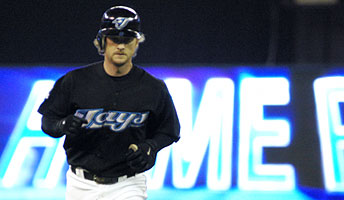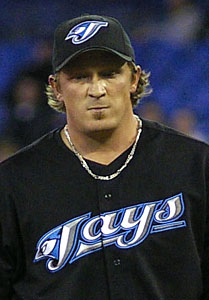 Earlier, Gregg Zaun had provided the at-bats to remember, first stroking a 3 run homer and later working the count nicely with the bases loaded before giving Matt Clement a nervous moment or two as he watched a potential grand slam flash before his eyes.
Earlier, Gregg Zaun had provided the at-bats to remember, first stroking a 3 run homer and later working the count nicely with the bases loaded before giving Matt Clement a nervous moment or two as he watched a potential grand slam flash before his eyes.
The middle innings of yesterday's game had some interesting strategic elements. In the top of the 5th, after walks to Ramirez and Nixon with one out and the Sox up 4-3, Jason Varitek laid down a sacrifice bunt off Towers. What followed was not really surprising, an intentional walk to Mike Lowell and Willie Harris making the 3rd out. Whether Varitek was bunting on his own or Francona called for it, the timing was inauspicious both because Towers was struggling and because of the lineup to follow. In the bottom of the 5th, Catalanotto singled and Vernon Wells was hit by a pitch. After Troy Glaus struck out, Lyle Overbay took 3 pitches high and wide from Matt Clement. Overbay took the 3-0 pitch, and eventually walked. I wondered whether he was given the 3-0 green light and took on his own.
In the top of the 6th with 2 out and Alex Gonzalez on first, Scott Schoeneweis came on for Towers to face David Ortiz. On the first pitch, Ortiz laid down a bunt in front of Troy Glaus for a single. Then, with the count 2-0 on Manny Ramirez and runners on first and second, the Jays decided to intentionally walk Ramirez for Schoeneweis to face Trot Nixon. Nixon cannot hit lefties, and the Sox did not wish to bring in Wily Mo Pena, a poor defender, in the situation. Later on, we had the bullpen moment. Vinnie Chulk came on in the top of the 8th and promptly walked a batter (Alex Gonzalez) and then gave up hits to Youkilis and Loretta to score a run. The Jays trailed 5-3, and there were runners on 1st and 2nd with nobody out and Ortiz up. Gibby called on B.J. Ryan who retired Ortiz, Ramirez and Nixon without incident. The curious thing to me about the decision to bring on Ryan was not that he was brought on in the eighth inning with his team trailing, but that he was brought in down 2 runs, rather than 1 at the beginning of the inning. In any event, it is good to see Ryan coming into the game in the 8th inning, and hopefully next time, it will be a higher leverage situation, even if it means facing a couple of right-handed hitters. He is the closer, but he is also The Man.
Later on, we had the bullpen moment. Vinnie Chulk came on in the top of the 8th and promptly walked a batter (Alex Gonzalez) and then gave up hits to Youkilis and Loretta to score a run. The Jays trailed 5-3, and there were runners on 1st and 2nd with nobody out and Ortiz up. Gibby called on B.J. Ryan who retired Ortiz, Ramirez and Nixon without incident. The curious thing to me about the decision to bring on Ryan was not that he was brought on in the eighth inning with his team trailing, but that he was brought in down 2 runs, rather than 1 at the beginning of the inning. In any event, it is good to see Ryan coming into the game in the 8th inning, and hopefully next time, it will be a higher leverage situation, even if it means facing a couple of right-handed hitters. He is the closer, but he is also The Man.
In the first installment of this series, we identified the 7 bullpens which had sustained success over a 3 year period during the last 30 years. Let's take a closer look at the first 3 teams.
Cincinnati Reds 1975-77
In 1975, the Reds had a fine pen with Rawly Eastwick and Will McEnaney, a fine left-right combination, taking most of the 9th innings, and workhorse Pedro Borbon and veteran Clay Carroll handling the rest. In 1976, 20 year old Manny Sarmiento joined the pen after Carroll was traded to the White Sox for Rich Hinton in the off-season. Sarmiento performed well in his debut season, and went on to a fine, if short, career. After their second straight World Series victory in 1976, the Reds shipped McEnaney and Tony Perez to the Expos for Woodie Fryman and Dale Murray. Murray was a serviceable 4th man out of the pen in 1977.
So, here are the Big Red Machine bullpen statistics:
| IP | H | ER | HR | W | K | H/9(Lg.) | W/9(Lg.) | HR/9(Lg.) | K/9(Lg.) | ERA (Lg.) | |
| Total | 1059 | 1092 | 365 | 60 | 283 | 483 | - | - | - | - | - |
| Annual Avg. | 353 | 364 | 122 | 20 | 94 | 161 | 9.3(8.8) | 2.4 (3.3) | 0.50 (0.70) | 4.1(5.1) | 3.11(3.67) |
Keep the ball in the strike zone, and in the park, and let Concepcion, Morgan, Geronimo and Bench do the rest. That seems like a good plan.
New York Yankees 76-83
This run really includes 2 distinct groups, with a year overlap. In 76-77, it was Sparky Lyle with Dick Tidrow providing most of the late-inning support. After the 1977 season, the Yanks signed Goose Gossage as a free agent, and he was the closer in 1978, with Lyle providing support. In mid-78, the Yanks acquired Ron Davis for Ken Holtzman. When Lyle was sent to Texas after 1978 in the Righetti deal, Davis took over the support role for Gossage and was in fact, the first set-up man with a very defined 7th and 8th inning role. This worked well from 1979-81. During 1982-1983, the bullpen comprised Gossage and journeymen relievers George Frazier, Dave LaRoche, sometimes Rudy May and (thank you!) Dale Murray. For those too young to remember, the Yanks acquired Murray from the Jays for Dave Collins and a minor leaguer. Fellow by the name of McGriff.
Here's what the Bronx Zoo pen looked like statisically:
| IP | H | ER | HR | W | K | H/9(Lg.) | W/9(Lg.) | HR/9(Lg.) | K/9(Lg.) | ERA (Lg.) | |
| Total | 2410 | 2267 | 818 | 167 | 792 | 1578 | - | - | - | - | - |
| Annual Avg. | 301 | 283 | 102 | 21 | 99 | 197 | 8.5(9.1) | 3.0 (3.2) | 0.60 (0.80) | 5.9(4.7) | 3.05(3.92) |
A classic power pen, anchored by Goose Gossage.
St. Louis Cardinals 1984-87
The Cardinals had Bruce Sutter in 1984 and Todd Worrell beginning in late 1985, but the remainder of the bullpen were your classic middle relievers- Neil Allen, Dave Von Ohlen, Ken Dayley, Jeff Lahti, Pat Perry, Ricky Horton...These were the Cards of Ozzie, Tommy Herr, Willie McGee and Andy Van Slyke, and the entire staff (including the bullpen) was built to take advantage of their defensive prowess. The Cards pen's statistical line reflected this
| IP | H | ER | HR | W | K | H/9(Lg.) | W/9(Lg.) | HR/9(Lg.) | K/9(Lg.) | ERA (Lg.) | |
| Total | 1514 | 1364 | 505 | 109 | 540 | 962 | - | - | - | - | - |
| Annual Avg. | 379 | 341 | 126 | 27 | 135 | 241 | 8.1(8.7) | 3.2 (3.3) | 0.60 (0.80) | 5.7(5.8) | 3.11(3.67) |
The Cards' pen seems to have had similar characteristics as the Reds' pen, albeit that it was not quite as extreme. A common feature of all three pens is their ability to avoid the home run. Part, but not all, of this was due to the parks in which these teams played.
We will check back on the other four pens in May, and see if any patterns emerge in the annual lines.




